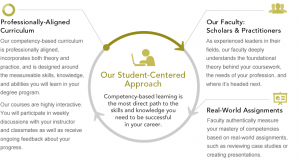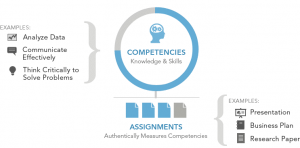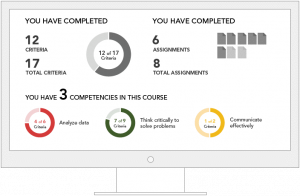35 Competency-Based Instruction
Teaching Strategies: Competency-Based Instruction
“Competency-based education is an outcomes-based approach to education where the emphasis is on what comes out of postsecondary education—what graduates know and can do—rather than what goes into the curriculum” (Soares, 2012, p. 2). Competency-based education doesn’t start from identifying the content of material students should learn, but rather it starts identifying competencies and then content that will support the student attainment of these competencies. “With a competency-based approach, students advance when they have demonstrated mastery of a competency, which is defined as “a combination of skills, abilities, and knowledge needed to perform a task in a specific context” (Soares, 2012, p.2). Competencies that must be mastered are agreed upon by students, faculty, employers, and policymakers after which students are free to select among different providers to personalize their learning.
Competency-based learning is characterized by flexible use of the time that allows students to progress at their own pace and advance upon demonstration of mastery (Donohue, 2013). Competency-based strategies provide flexibility in the way that credit can be earned or awarded and provide students with personalized learning opportunities. These strategies include online and blended learning, dual enrollment and early college high schools, project-based, and community-based learning, and credit recovery, among others. This type of learning leads to better student engagement because the content is relevant to each student and tailored to their unique needs. It also leads to better student outcomes because the pace of learning is customized to each student (Competency-based learning or personalized learning, 2012).
Increasingly we are being asked (by accrediting bodies, by legislators, by parents, and by the business community, among others) to demonstrate and certify that students have mastered specific skills, knowledge, and competencies, rather than simply providing a summative grade in a course. Competency-based instruction is the natural extension of basic principles of instructional design; it assumes that a curriculum has overarching competencies that are the threads that tie the individual courses together, and that those competencies are being taught and built upon throughout the Aristotelian arc of the courses that make up the curriculum. One means (among, perhaps, others) that people have tried to use to credential individual curricular competencies is through the use of badges — like a digital version of the boy scout or girl scout badges — that instructors can use to credential learners with specific skills or competencies. Examples of badges might be “technical writing”, “public speaking”, “self-learning”, “Java programming”, or “leadership”. As instructors across a curriculum see these skills emerging among their learners, they may choose to provide them with badges, or “level them up” in a badge that they have already been provided (such as a bronze, silver, and gold level of the “leadership” badge). The learners can choose to accept badges or not and display them in a wide range of places — such as their LinkedIn profiles, their Facebook profiles, in an ePortfolio, or on a personal website. The badges are linked back to a page with metadata indicating who was the issuer (in this case, MSU, Mankato), what the rubric for assigning the badge was, and, if available, demonstrations of mastery from the learner (such as a link to a web page that she or he created).
This strategy takes careful planning to create a competency-based lesson that is effective and engaging. We have created a planning document that walks you through the steps to creating a competency-based lesson or activity which can be found here: Competency-based Instruction Planning Template
This section outlines competency-based programs at other institutions as examples of how you might begin to think about adopting the aforementioned teaching strategy and the tools you might consider employing.
The U.S. Department of Education released a letter on March 19, 2013, endorsing competency-based education and encouraging interested colleges to seek federal approval for degree programs that do not rely on the credit hour to measure student learning. The letter can be found here. This document will illustrate some examples of programs that pilot in Competency-Based Learning.
- Southern New Hampshire University’s College for America
College for America’s competency-based model is the first in the nation to be approved by the Department of Education under direct assessment provisions that pay for actual learning versus seat time. It is a competency-based, self-paced, online program that offers a degree based on definable and measurable skills. Unlike the current model, where time is largely fixed around the three-credit hour course and not around how much a student learns, College for America is the first-degree program to completely decouple from credit hour, dispensing with courses and is instead built around 120 competencies (College of America, 2013).
The program doesn’t have instructors in the traditional sense, but students have a coach and a peer Accountability Partner. Students are required to demonstrate evidence of mastery through 120 competencies, where they accomplish specific tasks, which are scored by trained reviewers using analytic rubrics. According to the competency-based structure of the program, students are required to demonstrate the most relevant and necessary workforce skills-communication, critical thinking, quantitative literacy, and collaboration (College of America, 2013).
The University has used Lumina’s Degree Qualification Profile as the basis defining 120 competencies along with the university’s general education goals. Other sources were used as well, as the U.S. Department of Labor’s competency pyramids. The competencies are broken into 20 distinct “task families,” which are then divided into three task levels.
As students progress, they take assessments to measure their proficiency in the subject matter. When students demonstrate mastery of the competencies within a given task family, they will be deemed to have the knowledge and skills necessary to pass a 100- or 200-level, three-credit course, according to the university (Fain, 2012a).
During the study in the program, each student charts a path through 120 competencies, accessing curated learning resources that accompany each project. Once a student has satisfactorily completed a project, his progress is immediately reflected in a dynamic, online clickable transcript. The clickable transcripts include all the students’ artifacts along with the rubrics used to score them. Later these competencies can be mapped to traditional course credits for students who wish to transfer to four-year institutions (Kazin, 2013).
- Capella University
Capella University is among those institutions that are giving competency-based education a try. They enroll students in academic programs without courses, teaching professors, grades, deadlines, or credit hour requirements, but with a path to genuine college credit.
The biggest difference between the University of Capella and South New Hampshire University to some other institutions that offer competency-based programs is that they sever any link to the credit-hour standard. This approach is called “direct assessment”, which is the most extensive form of competency-based education. In “direct assessment” instructors don’t teach or lecture and don’t guide through the course material. Students in the experimental Capella courses have a choice between several suggested study guides or texts that relate to assessed competencies. Books are not required, and students can pick from suggested texts, ebooks, videos, journal articles, and even their experience at work to master competencies. This is all optional and students can skip reading about concepts they already know (Fain, 2013c).
Capella University defines its competency-based learning as comprised of three main components.

Graphic from http://www.capella.edu/about/competency-based-education/
The program uncovers the most desired skills and knowledge for any field and translates them into competencies. The assessment is authentic.

Graphic from http://www.capella.edu/about/competency-based-education/
Students will get grades for their work and competencies acquired, as well as have ongoing feedback from instructors. Students are also able to see their progress via a real-time competency map, as illustrated in the picture below (Capella University, 2010):

Graphic from http://www.capella.edu/about/competency-based-education/
- Western Governors University
Western Governors University is a fully online college experience in which technology does the teaching and students advance based on their mastery of content as opposed to the amount of time spent in a course. It was one of the earliest models of competency-based education that has begun to be taken to scale.
WGU’s competency-based approach to online education is personalized with the length of time-varying for students to complete a program. WGU uses a number of assessments including tests, projects, papers, and practical demonstration of a required skill. Students demonstrate mastery across a number of domains including general skills, as well as those specific to their degree program. Each student has a mentor who serves as an academic advisor and helps students manage the online environment. WGU defines the roles of faculty and administration differently than traditional universities. Students are assigned mentors who have a primary relationship with the students throughout their program. A council for each degree program brings together experts from the program field who approve the competency-based degrees and certificates. The assessment council is responsible for reviewing the credentialing assessments to ensure that the applications are valid measures of the competencies related to a given degree or certificate. WGU contracts with education providers for instructors for their online courses. All assessments are objective and proctored. Student work is assessed by graders. Program coordinators are responsible for maintaining the content, working with councils, and coordinating with the assessment department to ensure effective mechanisms to determine student performance on competencies. After the end of the year has passed, future teachers can update students’ proficiency ratings in the data system to reflect what they have learned since the conclusion of a course (Soares, 2012).
- Northern Arizona University
Northern Arizona is one of the universities that have jumped headfirst into competency-based education by offering “direct assessment” academic programs, which are self-paced and completely released from the credit hour. The testing and credentialing are different from other competency-based programs, including those from Western Governors University, which are still officially linked in some ways to the credit-hour standard. Students in Northern Arizona University who enroll in a new competency-based program will earn a second transcript, which will describe their proficiency in the online bachelor’s degree’s required concepts. The transcript differs from its traditional counterpart in that it doesn’t list courses and grades. You can find an example of the transcript here. Though according to experts, this document lacks some specific formulations, the overall effectiveness is higher from just listing courses and grades.
NAU anticipated the difficulties students will face when transferring to other universities or continuing their education in graduate programs in other institutions. To solve this problem students are getting two transcripts. NAU also mapped the learning outcomes from three-credit offerings to competencies in the new online programs and when students complete those lessons, they automatically earn credit equivalencies for the courses. For example, if they master several competencies that make up the course, their online dashboard automatically shows the course completed.
Currently, NAU offers three courses with competency-based learning and has a flat fee of $2500 unlimited credits for a six-month period. Learning is personalized and self-paced. It is structured on what a student already knows.
The length of the program depends on the learner’s preference about how many credits he wants to complete in a six-month subscription. The number of credits to be earned for the degree is 120. As there are no semesters; the students can start learning at any time once they have completed the necessary steps to be admitted. As the classes are online, the program has created “social” spaces within the Personalized Learning platform designed to provide easy access to instructors and mentors (Fain, 2013b).
On the Web
References
Capella University. (2010). Competency-based education. Retrieved from http://www.capella.edu/about/competency-based-education/
College of America. (2013). A milestone for competency-based higher ed. Informally published manuscript, Southern New Hampshire University, Available from http://collegeforamerica.org/latest/entry/a-milestone-for-competency-based-higher-ed.
Competency-based learning or personalized learning. (2012). Retrieved from http://www.ed.gov/oii-news/competency-based-learning-or-personalized-learning
Donohue, N. (2013, February 13). [Web log message]. Retrieved from http://www.educationnation.com/index.cfm?objectid=EC43BE66-6CB1-11E2-B644000C296BA163
Fain, P. (2012). A disruption grows up?. Inside Higher Education, doi: http://www.insidehighered.com/news/2013/08/02/new-assessments-testing-firms-have-job-market-potential
Fain, P. (2013). Competency-based transcripts. Inside Higher Education, Retrieved from http://www.insidehighered.com/news/2013/08/09/northern-arizona-universitys-new-competency-based-degrees-and-transcripts
Fain, P. (2013). Credit without teaching. Inside higher education, doi: http://www.insidehighered.com/news/2013/04/22/competency-based-educations-newest-form-creates-promise-and-questions
Hill, P. (2012, November 1). Online educational delivery models: A descriptive view. EDUCAUSE Review.
Kazin, K. (2013). Bringing higher education to where students live and work. Unpublished manuscript, Southern New Hampshire UniversityUniversity Innovation Lab, Available from https://net.educause.edu/ir/library/pdf/NG1228.pdf.
Soares, L. (2012, June 7). A ‘disruptive’ look at competency-based education:how the innovative use of technology will transform the college experience. Retrieved from http://www.americanprogress.org/issues/higher-education/report/2012/06/07/11680/a-disruptive-look-at-competency-based-education/

